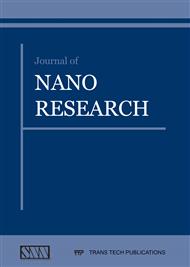[1]
Reichle W. T, Anionic clay minerals, Chemtech Press, (1986).
Google Scholar
[2]
C. M. Puscasu, E. M. Sefte, M. Mertens, P. Cool, G. Carja, ZnTi-LDH and the derived mixed oxides as photocatalysts for phenol degradation at room temperature, E-MRS 2014 Fall Meeting, September 15-19.
DOI: 10.1016/j.apcatb.2013.12.019
Google Scholar
[3]
V.R.L. Constantino, T. Pinnavaia, Basic properties of Mg2+ 1-xAl3+ x layered double hydroxides intercalated by carbonate, hydroxide, chloride, and sulfate anions, Inorg. Chem. 34 (1995) 883-892.
DOI: 10.1021/ic00108a020
Google Scholar
[4]
Z.P. Xu, J. Zhang, M.O. Adebajo, H. Zhang, C. Zhou, Catalytic applications of layered double hydroxides and derivatives, Appl. Clay Sci. 53 (2011) 139 -150.
DOI: 10.1016/j.clay.2011.02.007
Google Scholar
[5]
D.X. Gouveia, O.P. Ferreira, A.G. Souza, M.G. da Silva, J.A.C. de Paiva, O.L. Alves, J.M. Filho, Probing the thermal decomposition process of layered double hydroxides through in situ 57Fe Mössbauer and in situ X-ray diffraction experiments, J. Mater. Sci. 42 (2007).
DOI: 10.1007/s10853-006-1143-z
Google Scholar
[6]
A. Mendiboure, R. Schöllhorn, Formation and anion exchange reactions of layered transition metal hydroxides [Ni1―xMx] (OH)2(CO3)x/2(H2O)z(M=Fe, Co) Chim Miner. 23 (1987) 819 - 827.
DOI: 10.1002/chin.198723038
Google Scholar
[7]
Milica S., Hadnadev- Kostic, Tatjana J. Vulic, Dmitat B. Zoric, Radmila P. Marinkovic- Neducin, The influence of the UV irradiation intensity on photocatalytic activity of Zn-Al-Layered double hydroxides and derived mixed oxides, Chem Ind & Chem Engg Quart, 18 (2012).
DOI: 10.2298/ciceq110923006h
Google Scholar
[8]
Mingfei Shao, Jingbin Han, Min Wei, David G. Evans, Xue Duan, The synthesis of hierarchical Zn–Ti layered double hydroxide for efficient visible-light photocatalysis, Chem Engg J , 168 (2011) 519 - 524.
DOI: 10.1016/j.cej.2011.01.016
Google Scholar
[9]
M. Seftel, E. Popovici1, E. Beyers, M. Mertens, H. Y. Zhu, E. F. Vansant, and P. Cool, LDH and TiO2/LDH-type nanocomposite systems: A systematic study on structural Characteristics, J Nanosci Nanotech. 10 (2010) 1 - 7.
DOI: 10.1016/j.micromeso.2014.10.029
Google Scholar
[10]
Utraki, L. A, Clay-Containing Polymeric Nanocomposites, Rapra Technologies Ltd, (2004).
Google Scholar
[11]
Eduardo L. Crepaldi, Jairo Tronto, Lucelena P. Cardoso, Joa˜o B. Valim, Sorption of terephthalate anions by calcined and uncalcined hydrotalcite-like compounds, Colloids and Surfaces A: Physicochem. Eng. Aspects. 211 (2002) 103 - 114.
DOI: 10.1016/s0927-7757(02)00233-9
Google Scholar
[12]
Doesburg, E. B. M., P. H. M. De Korte, H. Schaper, and L. L. Van Reijen, The sintering of coprecipitated nickel alumina catalysts., Appl cataly, 11 (1984) 155 - 160.
DOI: 10.1016/s0166-9834(00)84050-6
Google Scholar
[13]
Williams, A., Butler, G. A., & Hammonds, J, Sintering of nickel-alumina catalysts, J of Cataly. 24 (1972) 352 – 355.
Google Scholar
[14]
Acharya, H., Srivastava, S. K., & Bhowmick, A. K, Synthesis of partially exfoliated EPDM/LDH nanocomposites by solution intercalation: structural characterization and properties. Comp Sci Tech. 67 (2007) 2807 - 2816.
DOI: 10.1016/j.compscitech.2007.01.030
Google Scholar
[15]
Cavani F, Trifiro F, Vaccari A: Hydrotalcite-type anionic clays: preparation, properties and applications. Catalysis Today; 11 (1991) 173 - 301.
DOI: 10.1016/0920-5861(91)80068-k
Google Scholar
[16]
El-Sayed M. A, Some interesting properties of metals confined in time and nanometer space of different shapes. Acc Chem resch, 34 (2001) 257 - 264.
DOI: 10.1021/ar960016n
Google Scholar
[17]
Govorov, A. O., Zhang, W., Skeini, T., Richardson, H., Lee, J., & Kotov, N. A, Gold nanoparticle ensembles as heaters and actuators: melting and collective plasmon resonances. Nanoscal Resch Lett, 1 (2006) 84 - 90.
DOI: 10.1007/s11671-006-9015-7
Google Scholar
[18]
Primo, A., Marino, T., Corma, A., Molinari, R., & Garcia, H, Efficient visible-light photocatalytic water splitting by minute amounts of gold supported on nanoparticulate CeO2 obtained by a biopolymer templating method. J Amer Chem Soc, 133 (2011).
DOI: 10.1021/ja2011498
Google Scholar
[19]
Liu, Z., Hou, W., Pavaskar, P., Aykol, M., & Cronin, S. B, Plasmon resonant enhancement of photocatalytic water splitting under visible illumination. Nano letters, 11 (2011) 1111 - 1116.
DOI: 10.1021/nl104005n
Google Scholar
[20]
Benalioua, B., Mansour, M., Bentouami, A., Boury, B., & Elandaloussi, E. H, The layered double hydroxide route to Bi–Zn co-doped TiO2 with high photocatalytic activity under visible light. J hazard mater, 288 (2015) 158 - 167.
DOI: 10.1016/j.jhazmat.2015.02.013
Google Scholar
[21]
Shan He, Shitong Zhang, Jun Lu, Yufei Zhao, Jing M, Min Wei, David G. Evans and Xue Duana, Enhancement of visible light photocatalysis by grafting ZnO nanoplatelets with exposed (0001) facets onto a hierarchical substrate. Chem Commun, 47 (2011).
DOI: 10.1039/c1cc14360c
Google Scholar
[22]
Hosni, K., Abdelkarim, O., Frini-Srasra, N., & Srasra, E: Synthesis, structure and photocatalytic activity of calcined Mg-Al-Ti-layered double hydroxides. Kor J Chem Engg, 2015, 32, 104 - 112.
DOI: 10.1007/s11814-014-0199-8
Google Scholar


